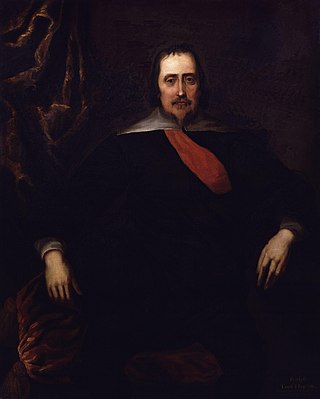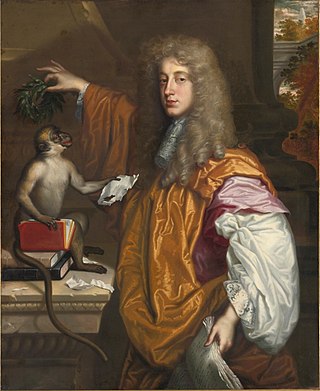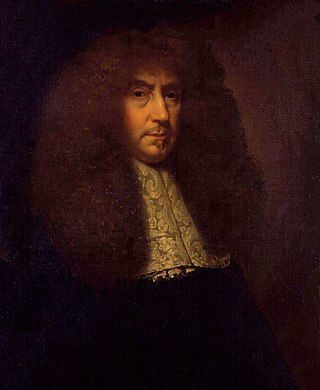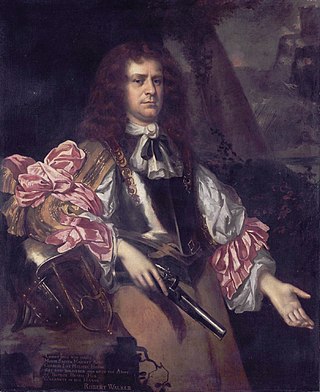
The English Civil War was a series of civil wars and political machinations between Royalists and Parliamentarians in the Kingdom of England from 1642 to 1651. Part of the wider 1639 to 1653 Wars of the Three Kingdoms, the struggle consisted of the First English Civil War and the Second English Civil War. The Anglo-Scottish War of 1650 to 1652 is sometimes referred to as the Third English Civil War.
The Whigs were a political party in the Parliaments of England, Scotland, Ireland, Great Britain and the United Kingdom. Between the 1680s and the 1850s, the Whigs contested power with their rivals, the Tories. The Whigs became the Liberal Party when the faction merged with the Peelites and Radicals in the 1850s. Many Whigs left the Liberal Party in 1886 over the issue of Irish Home Rule to form the Liberal Unionist Party, which merged into the Conservative Party in 1912.

Charles II was King of Scotland from 1649 until 1651 and King of England, Scotland, and Ireland from the 1660 Restoration of the monarchy until his death in 1685.

Roundheads were the supporters of the Parliament of England during the English Civil War (1642–1651). Also known as Parliamentarians, they fought against King Charles I of England and his supporters, known as the Cavaliers or Royalists, who claimed rule by absolute monarchy and the principle of the divine right of kings. The goal of the Roundheads was to give to Parliament the supreme control over executive administration of the country/kingdom.

Sir Charles Lucas, 1613 to 28 August 1648, was a professional soldier from Essex, who served as a Royalist cavalry leader during the Wars of the Three Kingdoms. Taken prisoner at the end of the First English Civil War in March 1646, he was released after swearing not to fight against Parliament again, an oath he broke when the Second English Civil War began in 1648. As a result, he was executed following his capture at the Siege of Colchester in August 1648, and became a Royalist martyr after the 1660 Stuart Restoration.

Edward Hyde, 1st Earl of Clarendon was an English statesman, lawyer, diplomat and historian who served as chief advisor to Charles I during the First English Civil War, and Lord Chancellor to Charles II from 1660 to 1667.

Edward Hyde, 3rd Earl of Clarendon, styled Viscount Cornbury between 1674 and 1709, was an English military officer, politician and colonial administrator. He was propelled into the forefront of English politics when he and part of his army defected from the Catholic King James II to support the newly arrived Protestant contender, William III of Orange. These actions were part of the beginning of the Glorious Revolution of 1688. Cornbury's choice to support his cousin Anne instead of William after the rebellion cost him his military commission. However, Cornbury's support of King William's reign eventually earned him the governorship of the provinces of New York and New Jersey; he served between 1701 and 1708.

Ralph Hopton, 1st Baron Hopton was an English politician, military officer and peer. During the First English Civil War, he served as Royalist commander in the West Country, and was made Baron Hopton of Stratton in 1643.
The Tories were a loosely organised political faction and later a political party, in the Parliaments of England, Scotland, Ireland, Great Britain and the United Kingdom. They first emerged during the 1679 Exclusion Crisis, when they opposed Whig efforts to exclude James, Duke of York from the succession on the grounds of his Catholicism. Despite their fervent opposition to state-sponsored Catholicism, Tories opposed his exclusion because of their belief that inheritance based on birth was the foundation of a stable society.

The term Cavalier was first used by Roundheads as a term of abuse for the wealthier royalist supporters of Charles I of England and his son Charles II during the English Civil War, the Interregnum, and the Restoration. It was later adopted by the Royalists themselves. Although it referred originally to political and social attitudes and behaviour, of which clothing was a very small part, it has subsequently become strongly identified with the fashionable clothing of the court at the time. Prince Rupert, commander of much of Charles I's cavalry, is often considered to be an archetypal Cavalier.
Charles Leslie was a former Church of Ireland priest who became a leading Jacobite propagandist after the 1688 Glorious Revolution. One of a small number of Irish Protestants to actively support the Stuarts after 1688, he is best remembered today for his role in publicising the 1692 Massacre of Glencoe.

John Colepeper, 1st Baron Culpeper was an English peer, military officer and politician who, as Chancellor of the Exchequer (1642–43) and Master of the Rolls (1643) was an influential counsellor of King Charles I during the English Civil War, who rewarded him with a peerage and some landholdings in Virginia. During the Commonwealth he lived abroad in Europe, where he continued to act as a servant, advisor and supporter of King Charles II in exile. Having taken part in the Prince's escape into exile in 1646, Colepeper accompanied Charles in his triumphant return to England in May 1660, but died only two months later. Although descended from Colepepers of Bedgebury, Sir John was of a distinct cadet branch settled at Wigsell in the parish of Salehurst.

Earl of Rochester was a title that was created twice in the Peerage of England. The first creation came in 1652 in favour of the Royalist soldier Henry Wilmot, 2nd Viscount Wilmot. He had already been created Baron Wilmot, of Adderbury in the County of Oxford, in 1643, also in the Peerage of England. He was the son of Charles Wilmot, who had been elevated to the Peerage of Ireland as Viscount Wilmot, of Athlone, in 1622. Lord Rochester died in 1658 and was succeeded by his son John Wilmot, 2nd Earl of Rochester. He was a poet, a friend of King Charles II, and the writer of satirical and bawdy poetry. He married the heiress Elizabeth Malet. He was succeeded on his death in 1680 by his only son, the third Earl. He, in turn, died at a young age the following year, when the titles became extinct.
Henry Hyde, 4th Earl of Clarendon and 2nd Earl of Rochester, PC, styled Lord Hyde from 1682 to 1711, was an English Army officer and Tory politician who sat in the English and British House of Commons from 1692 until 1711 when he succeeded to the peerage as Earl of Rochester.

Sir Robert Long, 1st Baronet of Westminster was an English courtier and administrator who sat in the House of Commons at various times between 1626 and 1673.

Sir Edward Harley was an English politician from Herefordshire. A devout Puritan who fought for Parliament in the First English Civil War, Harley belonged to the moderate Presbyterian faction, which opposed the involvement of the New Model Army in the peace negotiations that followed victory in 1646. Elected MP for Herefordshire in 1646, he was one of the Eleven Members forced into temporary exile by the army in 1647.

Lieutenant-Colonel George Joyce was an officer and Agitator in the Parliamentary New Model Army during the English Civil War.
The Treaty of Neutrality signed on 29 September 1642 by Lord Fairfax for Parliament and Henry Bellasis for the Royalists, the two Knights of the Shire who represented Yorkshire in Parliament, with the support and agreement of other gentlemen of the county, in the hope of avoiding civil war in Yorkshire. The treaty was disowned by Parliament on 4 October 1642.

Joseph Bampfield (1622–1685) was an English soldier and spy, who served with the Royalist army in the Wars of the Three Kingdoms, then became an intelligence agent for The Protectorate. Banished from England after the 1660 Stuart Restoration, he moved to the Dutch Republic and joined the Dutch States Army when the Second Anglo-Dutch War began in 1665. As a result he was convicted of treason by Parliament and never returned home.
Paul Seaward is a British historian specialising in seventeenth-century English history.















